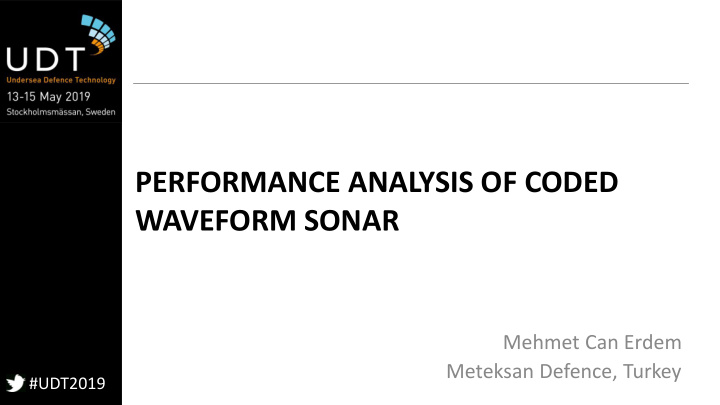



PERFORMANCE ANALYSIS OF CODED WAVEFORM SONAR Mehmet Can Erdem Meteksan Defence, Turkey #UDT2019
Classical Sonar Waveforms • CW : Long pulses reduce range resolution. But Doppler resolution is good • FM : Range resolution is good but Doppler information is satisfactory. • CW/FM combined #UDT2019
Phase Coded Waveforms • Types: Binary phase (Barker, pseudo noise, ...), polyphase (Frank, Zadoff- Chu, ...) • Pros • Simple • Combines CW and FM advantages • Resistant against multipath • Allows multi sonar operation in same region • Cons • Pulse compression ratio is lower than FM • It is hard to transmit signal without distortion • Doppler resolution is low #UDT2019
Ambiguity Function (AF) of CW, FM and PRN Waveforms #UDT2019
Simulation Architecture Conformal Array Radius = 0.25 m (torpedo), 2.5 m (submarine) Target Range = 5 km (submarine), 4 km (surface ship) Range_resolution = 10 m Source Depth = 100 m (submarine), 500 m (surface ship) Pulse_Width = 80 ms Target Depth = 400 m (submarine), 10 m (surface ship) Profile = Munk Target Strength = 10 dB Ambient Noise for sea state 4 = 55 dB at 8 kHz, 50 dB at 20 kHz Target Range = 10 km 100 Monte Carlo Runs for each case Target Doppler = 5 kts #UDT2019
Simulation Results Case 1: A submarine detecting another submarine. Frequency = 8 kHz, CFAR Probability of False Alarm = 2 % Coded Coded CW LFM Waveform Waveform (Barker) (Frank) Probability of 0.99 0.55 0.83 0.98 detection False alarm 5.849 x 10 -5 4.906 x 10 -5 3.83 x 10 -4 4.717 x 10 -5 rate Doppler Speed 0.19 2.26 2.13 1.23 Error (m/s) #UDT2019
Simulation Results Case 2: A torpedo detecting a submarine. Frequency = 20 kHz, CFAR Probability of False Alarm = 2 % Coded Coded Waveform CW LFM Waveform (Barker) (Frank) Probability of 0.85 0.42 0.61 0.85 detection False alarm 6.98 x 10 -5 1.11 x 10 -4 6.094 x 10 -4 2.076 x 10 -5 rate Doppler Speed Error 0.08 6.64 4.24 1.1 (m/s) #UDT2019
Simulation Results Case 3: A submarine detecting a surface ship. Frequency = 8 kHz, CFAR Probability of False Alarm = 1 % Coded Coded CW LFM Waveform Waveform (Barker) (Frank) Probability of 0.44 0.53 0.88 0.98 detection False alarm 9.34 x 10 -6 1.887 x 10 -5 1.887 x 10 -6 0 rate Doppler Speed Error 0.65 1.25 0.67 0.37 #UDT2019 (m/s)
Case 3 Doppler Map (CW Pulse) #UDT2019
Case 3 Doppler Map (FM Pulse) #UDT2019
Case 3 Doppler Map (Barker Code) #UDT2019
Case 3 Doppler Map (Frank Code) #UDT2019
Results • The probability of detection statistics and false alarm rate of Frank polyphase coded waveform are generally better other pulses, which confirms their advantages while Doppler estimation of CW is better in some cases. • The maximum length of Barker code is 13, which limits its performance compared to other waveforms like Frank having 16 chips but is a better alternative than CW and FM in some situations. #UDT2019
Limitations • The AF of the simulations generally exhibit larger sidelobe levels in range and Doppler axis than theoretical values due to multipaths, exposing the need for proper filter design in Doppler processing. • The simulation framework does not model the hardware limitations such as the amplifier responses, the transducer responses and the nonlinearities of electronic components. Therefore the signals in the simulations are assumed to be generated and transmitted without distortion in the context of this study. • The Bellhop Ray Tracing is known to be accurate at high frequencies and deep water environment which is the case for this study. Other methods like normal mode, parabolic equation should be used for satisfactory results for low frequencies and shallow water environment. #UDT2019
Implementation and applicability challenges • Despite their advantages, phase coded waveforms are not unimodular and the energy has to be normalized so that the power amplifier can properly transmit the signal without distorting. • Numerous phase shifts in polyphase codes require quadratic modulators and complex signal processors, which may cause a limitation for practical applications having traditional hardware #UDT2019
Future Work Expanding naval interest in operations in littoral regions has resulted in renewed interest in advanced waveform designs for Low Frequency Active (LFA) sonars. Some other techniques in recent studies propose the following signal structures for LFA sonar: • Long M-sequences with reduced power • Hyperbolic FM • Costas Frequency Hopped Signals • Costas based signal with LFM sub-pulses • The cyclic algorithm new (CAN) based signals #UDT2019
Recommend
More recommend